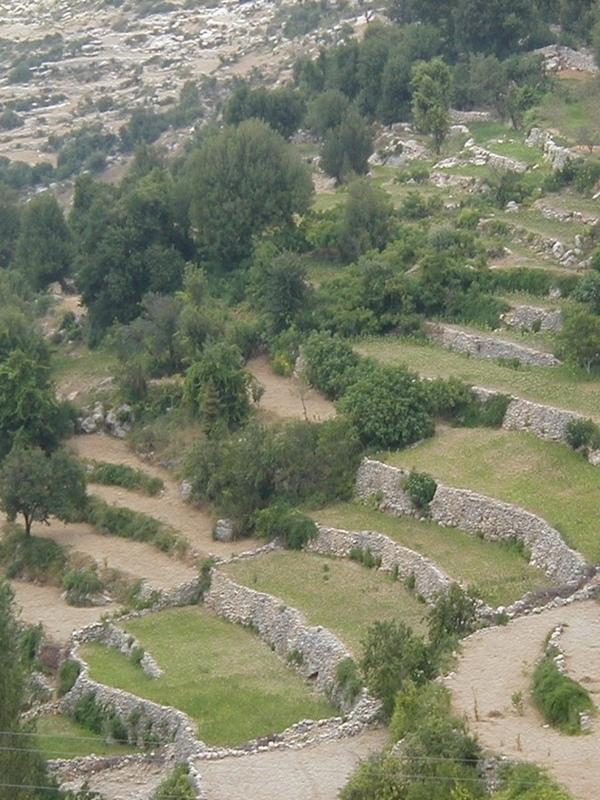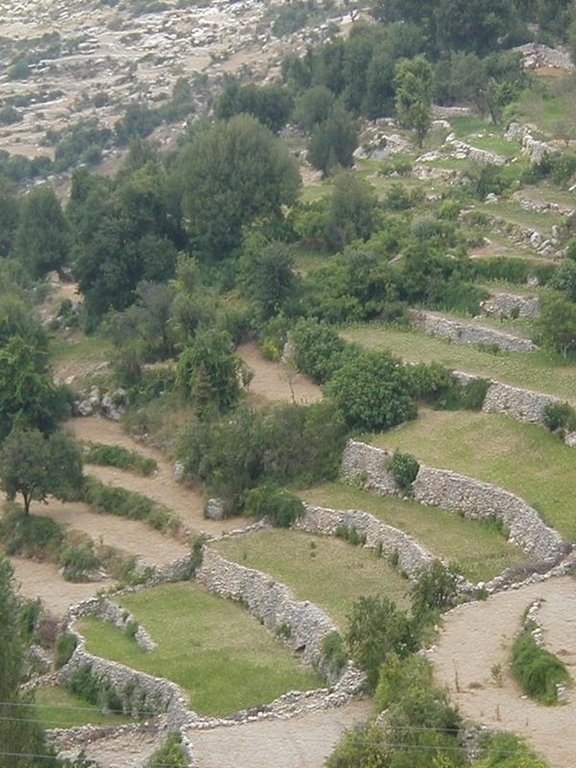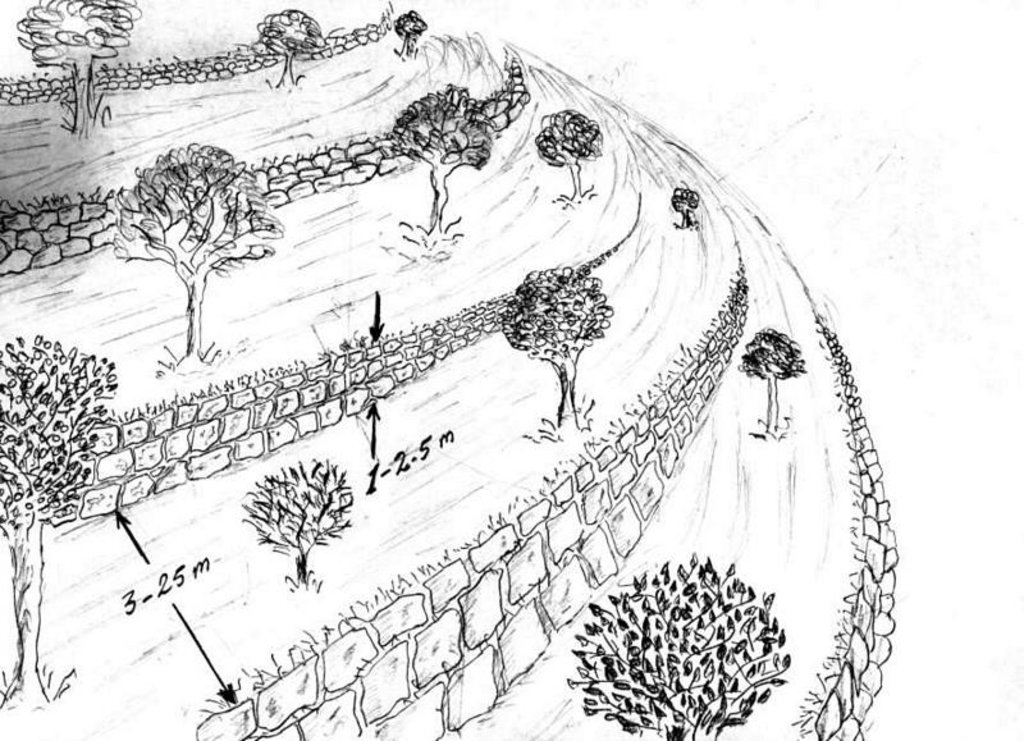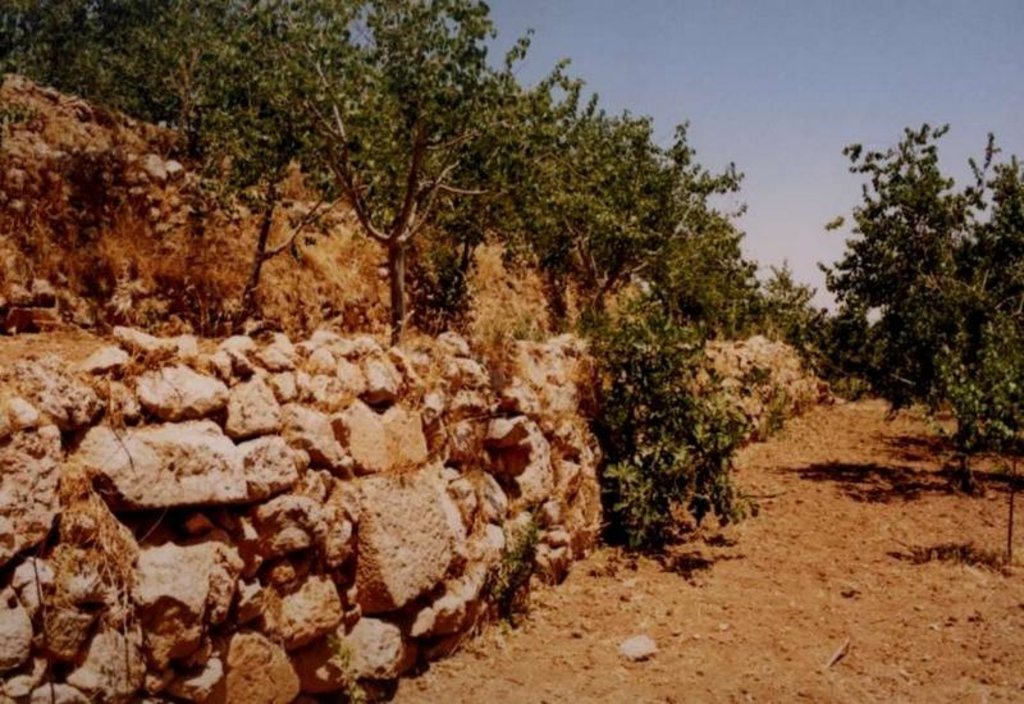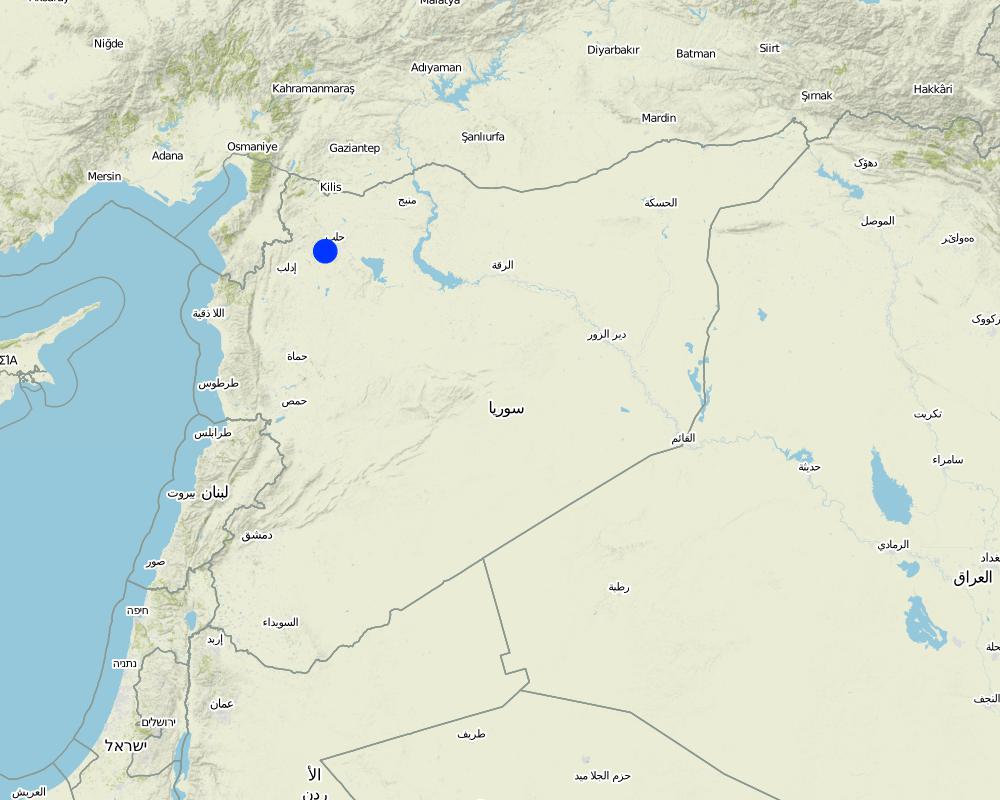Stone Wall Bench Terraces [阿拉伯叙利亚共和国]
- 创建:
- 更新:
- 编制者: Michael Zoebisch
- 编辑者: –
- 审查者: Fabian Ottiger, Alexandra Gavilano
Mudarrajad Hajaria (Arabic)
technologies_1411 - 阿拉伯叙利亚共和国
查看章节
全部展开 全部收起1. 一般信息
1.2 参与该技术评估和文件编制的资源人员和机构的联系方式
SLM专业人员:
SLM专业人员:
SLM专业人员:
SLM专业人员:
SLM专业人员:
Salem Salwa
ICARDA Syria
阿拉伯叙利亚共和国
有助于对技术进行记录/评估的项目名称(如相关)
Book project: where the land is greener - Case Studies and Analysis of Soil and Water Conservation Initiatives Worldwide (where the land is greener)有助于对技术进行记录/评估的机构名称(如相关)
International Center for Agricultural Research in the Dry Areas (ICARDA) - 黎巴嫩1.3 关于使用通过WOCAT记录的数据的条件
编制者和关键资源人员接受有关使用通过WOCAT记录数据的条件。:
是
2. SLM技术的说明
2.1 技术简介
技术定义:
Ancient level bench terraces with stone walls, built to stabilise slopes, retain moisture, and create a suitable environment for horticulture.
2.2 技术的详细说明
说明:
Stone wall bench terraces in the hill ranges of western Syria comprise an ancient indigenous technology, introduced by the Romans and Byzantines about 2,000 years ago. Some new terraces are, however, still being built. The walls are constructed with limestone, largely found on site. The terraces are located in steep terrain (usually on slopes more than 25%) under low (and erratic) rainfall regimes of between 250 and 500 mm per annum. The terrace walls are 1-2.5 m high and the level beds 3-25 m wide, depending on slope.
Deep soil profiles (more than 2 m) have developed on steep slopes, where original soil depth was only shallow to medium. The terraces are very efficient in preventing soil erosion and in the retention of rainfall. They support trees and annual crops where they could not otherwise be grown.
These terraces are usually found near settlements. Construction is very labour intensive, considering how little land is effectively protected from erosion and brought into cultivation. High labour investment makes the construction process slow and retards further extension of the technology. However, if soundly constructed, maintenance requirements are low. Underlining this point, a large number of very ancient terraces can still be found intact, supporting a productive crop. Sometimes localised collapse of a terrace occurs due to concentrated runoff. In that case, the terrace in question may need to be rebuilt. To prevent such breaches, it is important to allow for discharge of excess runoff along drainage lines.
Currently, most terraces are used to grow fruit trees. These include olives, cherries, almonds, plums, pomegranates, apricots, and peaches. Husbandry practices are normally carried out by hand. Where space permits, however, draft animals are used for tillage. The curves of the terraces and access to the steep slopes make it very difficult/impossible to use tractors. Animal power is more versatile in this irregular landscape, but it is more expensive than tractor power, due to shortage of fodder.
2.3 技术照片
2.5 已应用该技术的、本评估所涵盖的国家/地区/地点
国家:
阿拉伯叙利亚共和国
区域/州/省:
Idleb Province, Ariha District
有关地点的进一步说明:
Tal Lata Village
具体说明该技术的分布:
- 均匀地分布在一个区域
如果不知道精确的区域,请注明大致覆盖的区域:
- 1-10 平方千米
Map
×2.6 实施日期
如果不知道确切的年份,请说明大概的日期:
- 50多年前(传统)
2.7 技术介绍
详细说明该技术是如何引入的:
- 作为传统系统的一部分(> 50 年)
注释(项目类型等):
The technology was most probably developed and introduced during the Roman/Byzantine period, 200-400 AD
3. SLM技术的分类
3.1 该技术的主要目的
- 改良生产
- 创造有益的经济影响
3.2 应用该技术的当前土地利用类型

农田
- 乔木与灌木的种植
乔木和灌木种植 - 指定作物:
- 橄榄树
- 核果(桃、杏、樱桃、李子等)
- 树坚果(巴西坚果、开心果、核桃、杏仁等)
- pomegranates
每年的生长季节数:
- 1
具体说明:
Longest growing period in days: 180 Longest growing period from month to month: Nov - Apr
注释:
Major land use problems (compiler’s opinion): Before terracing, water erosion resulted in shallow to medium colluvial soils. Terracing made cultivation possible, but the
beds tend to be very narrow and/or irregularly shaped, with large boulders set in them, making tractor cultivation (which is cheap) impossible.
Major land use problems (land users’ perception): (1) Soil tillage - mechanization is difficult; animal power is up to 5 times more expensive than tractor power.
(2) Rockiness of the soil - large and very large stones make cultivation difficult.
(3) Accessibility - inadequate road network to reach fields
3.4 供水
该技术所应用土地的供水:
- 雨养
3.5 该技术所属的SLM组
- 横坡措施
3.6 包含该技术的可持续土地管理措施

农艺措施
- A3:土壤表面处理
注释:
Main measures: structural measures
3.7 该技术强调的主要土地退化类型

土壤水蚀
- Wt:表土流失/地表侵蚀

水质恶化
- Ha:干旱化
注释:
Main type of degradation addressed: Wt: loss of topsoil / surface erosion, Ha: aridification
3.8 防止、减少或恢复土地退化
具体数量名该技术与土地退化有关的目标:
- 防止土地退化
4. 技术规范、实施活动、投入和成本
4.1 该技术的技术图纸
技术规范(与技术图纸相关):
other/ national currency (specify):
Syrian Pounds
If relevant, indicate exchange rate from USD to local currency (e.g. 1 USD = 79.9 Brazilian Real): 1 USD =:
50.0
Indicate average wage cost of hired labour per day:
作者:
Mats Gurtner
4.2 有关投入和成本计算的一般信息
其它/国家货币(具体说明):
Syrian Pounds
如相关,注明美元与当地货币的汇率(例如1美元=79.9巴西雷亚尔):1美元=:
50.0
注明雇用劳工的每日平均工资成本:
3.00
4.3 技术建立活动
| 活动 | 时间(季度) | |
|---|---|---|
| 1. | Levelling the terrace bed by bulldozers where necessary. | 0.35-0.7 persondays/m for all activities |
| 2. | Blasting rocks in the field | |
| 3. | Collecting stones for wall building – which are available locally. | |
| 4. | Building the stone walls with 1–2.5 m vertical interval (and therefore | |
| 5. | Levelling land between stone walls. |
4.4 技术建立所需要的费用和投入
| 对投入进行具体说明 | 单位 | 数量 | 单位成本 | 每项投入的总成本 | 土地使用者承担的成本% | |
|---|---|---|---|---|---|---|
| 劳动力 | Labour | ha | 1.0 | 1260.0 | 1260.0 | 100.0 |
| 劳动力 | Stone collection | ha | 1.0 | 50.0 | 50.0 | 100.0 |
| 设备 | Machine use | ha | 1.0 | 50.0 | 50.0 | 100.0 |
| 设备 | Tools | ha | 1.0 | 50.0 | 50.0 | 100.0 |
| 设备 | Drill | ha | 1.0 | 5.0 | 5.0 | 100.0 |
| 肥料和杀菌剂 | Ammonium nitrate(kg) | ha | 1.0 | 15.0 | 15.0 | 100.0 |
| 施工材料 | Stone | ha | 1.0 | |||
| 施工材料 | Detonators | ha | 1.0 | 10.0 | 10.0 | 100.0 |
| 施工材料 | Fuses (m) | ha | 1.0 | 20.0 | 20.0 | 100.0 |
| 技术建立所需总成本 | 1460.0 | |||||
| 技术建立总成本,美元 | 29.2 | |||||
注释:
Duration of establishment phase: 6 month(s)
4.5 维护/经常性活动
| 活动 | 时间/频率 | |
|---|---|---|
| 1. | Repairing (replacing stones) | 5 persondays required/every year |
4.6 维护/经常性活动所需要的费用和投入(每年)
| 对投入进行具体说明 | 单位 | 数量 | 单位成本 | 每项投入的总成本 | 土地使用者承担的成本% | |
|---|---|---|---|---|---|---|
| 劳动力 | Labour | ha | 1.0 | 15.0 | 15.0 | 100.0 |
| 设备 | Tools | ha | 1.0 | 5.0 | 5.0 | 100.0 |
| 施工材料 | Stone | ha | 1.0 | |||
| 技术维护所需总成本 | 20.0 | |||||
| 技术维护总成本,美元 | 0.4 | |||||
注释:
Manual construction work requires 0.35-0.7 person days per metre length of terrace wall. Establishment costs were calculated for an average of 600 m length of stone wall (height 2 m, width 70 cm) per hectare on a 12% slope, with
terrace beds therefore about 16-17 metres wide. Narrower terraces on steeper slopes are considerably more expensive to construct.
4.7 影响成本的最重要因素
描述影响成本的最决定性因素:
Labour shortage and labour cost
5. 自然和人文环境
5.1 气候
年降雨量
- < 250毫米
- 251-500毫米
- 501-750毫米
- 751-1,000毫米
- 1,001-1,500毫米
- 1,501-2,000毫米
- 2,001-3,000毫米
- 3,001-4,000毫米
- > 4,000毫米
农业气候带
- 半干旱
5.2 地形
平均坡度:
- 水平(0-2%)
- 缓降(3-5%)
- 平缓(6-10%)
- 滚坡(11-15%)
- 崎岖(16-30%)
- 陡峭(31-60%)
- 非常陡峭(>60%)
地形:
- 高原/平原
- 山脊
- 山坡
- 山地斜坡
- 麓坡
- 谷底
垂直分布带:
- 0-100 m a.s.l.
- 101-500 m a.s.l.
- 501-1,000 m a.s.l.
- 1,001-1,500 m a.s.l.
- 1,501-2,000 m a.s.l.
- 2,001-2,500 m a.s.l.
- 2,501-3,000 m a.s.l.
- 3,001-4,000 m a.s.l.
- > 4,000 m a.s.l.
关于地形的注释和进一步规范:
Slopes on average: Also rolling (ranked 3)
5.3 土壤
平均土层深度:
- 非常浅(0-20厘米)
- 浅(21-50厘米)
- 中等深度(51-80厘米)
- 深(81-120厘米)
- 非常深(> 120厘米)
土壤质地(表土):
- 中粒(壤土、粉土)
- 细粒/重质(粘土)
表土有机质:
- 中(1-3%)
如有可能,附上完整的土壤描述或具体说明可用的信息,例如土壤类型、土壤酸碱度、阳离子交换能力、氮、盐度等。:
Soil fertility: Medium (ranked 1) and low (ranked 2)
Soil drainage/infiltration: Medium
Soil water storage capacity: Medium
5.6 应用该技术的土地使用者的特征
生产系统的市场定位:
- 混合(生计/商业)
- 商业/市场
非农收入:
- > 收入的50%
机械化水平:
- 手工作业
- 畜力牵引
说明土地使用者的其他有关特征:
Population density: > 500 persons/km2
Annual population growth: 3% - 4%
Relative level of wealth: very rich, rich, average, poor
3% of the land users are very rich and own 20% of the land (very few).
7% of the land users are rich and own 20% of the land (few,).
40% of the land users are average wealthy and own 30% of the land (Many).
50% of the land users are poor and own 30% of the land (Many).
Off-farm income specification: On average, 70 % of the income is from off-farm activities
5.7 应用该技术的土地使用者使用的平均土地面积
- < 0.5 公顷
- 0.5-1 公顷
- 1-2 公顷
- 2-5公顷
- 5-15公顷
- 15-50公顷
- 50-100公顷
- 100-500公顷
- 500-1,000公顷
- 1,000-10,000公顷
- > 10,000公顷
注释:
The overall range is 0.5-7 ha
5.8 土地所有权、土地使用权和水使用权
土地所有权:
- 个人,有命名
土地使用权:
- 个人
6. 影响和结论性说明
6.1 该技术的现场影响
社会经济效应
生产
作物生产
饲料质量
木材生产
土地管理
收入和成本
农业收入
工作量
注释/具体说明:
Mechanisation is not possible
社会文化影响
社区机构
国家机构
冲突缓解
注释/具体说明:
But a potential for conflict if the community refuses to participate in joint maintenance activities
生态影响
水循环/径流
多余水的排放
土壤
土壤水分
土壤覆盖层
土壤流失
养分循环/补给
生物多样性:植被、动物
植物多样性
动物多样性
栖息地多样性
减少气候和灾害风险
风速
6.2 该技术的场外影响已经显现
下游洪水
下游淤积
地下水/河流污染
6.4 成本效益分析
技术收益与技术建立成本相比如何(从土地使用者的角度看)?
短期回报:
消极
长期回报:
积极
技术收益与技术维护成本/经常性成本相比如何(从土地使用者的角度看)?
短期回报:
积极
长期回报:
积极
6.5 技术采用
如若可行,进行量化(住户数量和/或覆盖面积):
39
注释:
5% of land user families have adopted the Technology with external material support
2 land user families have adopted the Technology with external material support
95% of land user families have adopted the Technology without any external material support
37 land user families have adopted the Technology without any external material support
There is no trend towards spontaneous adoption of the Technology
Comments on adoption trend: The rate of spontaneous adoption is low because of the high costs.
6.7 该技术的优点/长处/机会
| 编制者或其他关键资源人员认为的长处/优势/机会 |
|---|
|
Soil and water is conserved and fruit crop yields are maintained/increased How can they be sustained / enhanced? Combine with soil fertility improvement (such as farm yard manure). The prices of the crops grown should remain adequate |
|
The maintenance requirements are low. The terraces need little repair How can they be sustained / enhanced? Natural drainage lines must be prepared/maintained to prevent collapse during heavy rainfall. |
| The terraces make the cultivation of trees on hill slopes possible. |
6.8 技术的弱点/缺点/风险及其克服方法
| 编制者或其他关键资源人员认为的弱点/缺点/风险 | 如何克服它们? |
|---|---|
| The establishment costs are high | Plant high value cash crops. |
| The mechanisation of farm operations is impossible because there is no access to the terraces for tractors, while animal power is constrained by high maintenance costs (fodder). Thus, field operations are limited to hand labour | Subsidise mule ploughing. |
7. 参考和链接
7.1 信息的方法/来源
7.2 参考可用出版物
标题、作者、年份、ISBN:
Mushallah AB. The visible and the hidden in the country of olives. pp 463. 2000.
可以从哪里获得?成本如何?
Akrama Publ. Office. Damascus, Syria.
链接和模块
全部展开 全部收起链接
无链接
模块
无模块


